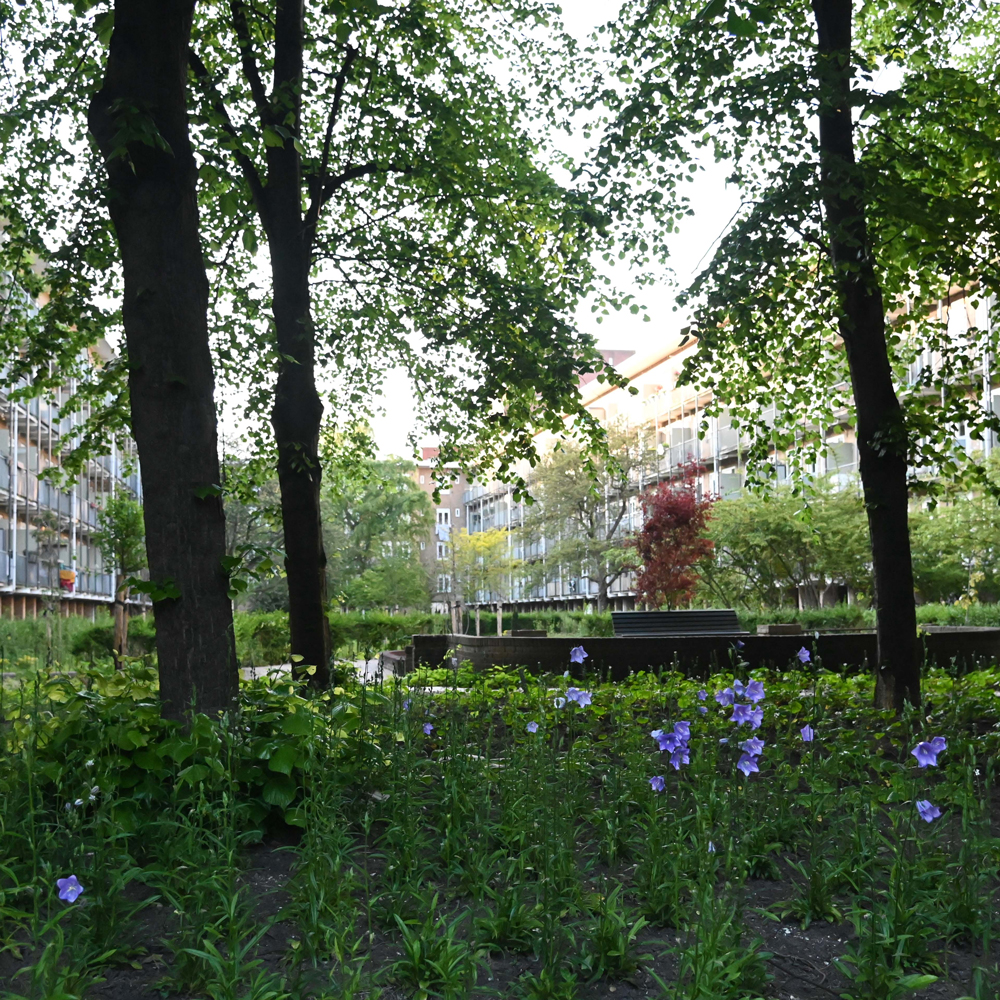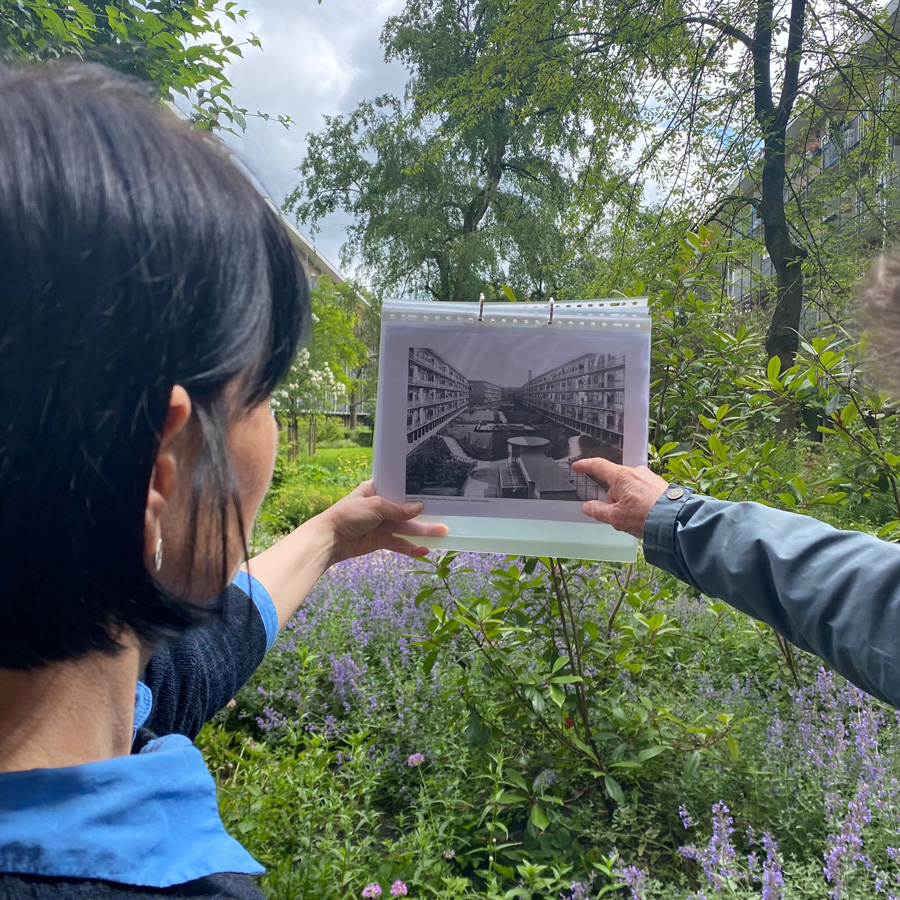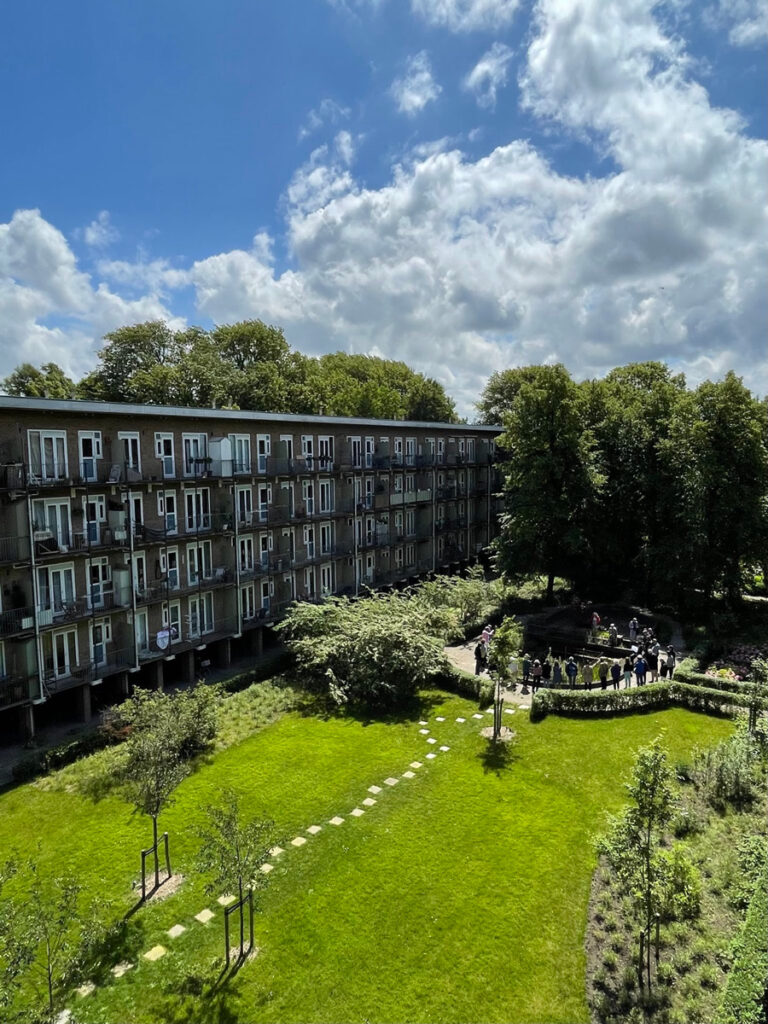Social Green – Lessons from Geuzenhof and beyond
Gerlinde Schuller
The research project investigates the right balance between social and green – a balance that can help us solve a crucial dilemma: Do we prioritize economic growth to improve the political climate, or do we focus on rights of nature to address the climate crisis? And what is the middle ground that unites both interests?
The social-green history of the Geuzenhof complex in Amsterdam (NL) serves as a case study spanning over 120 years. My research then zooms out to a global perspective.
LECTURES AND CITY TOURS
I give lectures and city tours on the topic of Social Green, both in general and with a specific focus on the Geuzen neighborhood.
If you would like to book a session, please contact me at: studio (at) theworldasflatland.net
Social Green – City Tour
You can book here a city tour about Social Green in Dutch and English.
Next lecture
My next lecture on the social green heritage of the Geuzenhof is on January 26, 2026, 14:00 o’clock at Stadsherstel in Amsterdam (NL).
WEB PUBLICATION
I translated my historical research about the Geuzenhof into four comprehensive articles on the new collection platform of the National Collection for Dutch Architecture and Urban Planning.
The articles, published in three languages, present 550 media items, including documents from 35 public and private archives, as well as material from 45 interviews.
Best read on a large screen.
Het verhaal van Geuzenhof (in Dutch)
Die Geschichte des Geuzenhof (in German)
The Story of Geuzenhof (in English)
EXHIBITIONS
The exhibition The People of Geuzenhof complements the web publication, focusing on the creators, residents, and experts who keep the heritage of the Geuzenhof alive.
At Rotterdam Architecture Month
June 1-30, 2025
At Arcam, Architecture Centre Amsterdam
February 6-April 6, 2025
The opening at Arcam will be followed by a panel discussion on ‘Urban Social Green’, with participants including Melanie van der Horst, Alderman for Public Space and Green for the City of Amsterdam, architect Marc Reniers, and data journalist Gerlinde Schuller.
RESEARCH TOPICS
How can we build and live green and social at the same time?
Amsterdam’s expansion plans, developed in the early 19th century, were based on an interplay of nature and social housing. Garden cities in England and Germany, which were also supposed to fulfil an important social function, served as inspiration. The aim was to provide the poorest city dwellers with a garden – in the form of a communal garden, a sight garden, a green belt or a man-made forest – in addition to cheap rental housing.
“The construction of social housing, which is not for sale but for self-management, not only meets the requirements of the time in social and economic terms, but also anticipates to a limited extent what can be demanded and expected in terms of living comfort in the future.”
Huibert van Saane, envisionair and constructor of Geuzenhof
Performing a social experiment
Political decisions led to an increase in social housing from the 1930s and a drastic decrease from the 1990s. Geuzenhof (586 flats), belonging to the Expansion Plan Landlust, was one of the first social building experiments of this size in Amsterdam and is therefore a good case study to illustrate this development.
At the beginning of Geuzenhof stood a collaboration of well-known creative and socially engaged personalities, including urban planners Cornelis van Eesteren and Jakoba Mulder, building contractor Huibert van Saane, architects Jacob Dunnebier and Johannes F. Berghoef, garden architect Mien Ruys and industrial designer Piet Zwart.
“Above all, we are talking about a plan for the Amsterdam of the future – in an old city like Amsterdam, not an easy undertaking.”
Cornelis van Eesteren, urban planner and co-designer the Expansion Plan Landlust
“A residential neighbourhood must be designed in such a way that community life can develop; there must be cohesion between the residents. It is socially desirable; the common good will benefit from it.”
Jakoba Mulder, urban planner, created the public playground next to the Geuzenhof
The creator of Geuzenhof, Huibert van Saane, also believed that nature was a social enrichment and integrated two generous communal gardens into his estate. For their design, he commissioned garden architect Mien Ruys, who later achieved international renown. It was her first social housing project.
Preserving architectural heritage
In the 1970/80s, the property is taken over by various companies and quickly sold off again. The administration is outsourced and the sale of social housing begins. The Geuzenhof is poorly maintained and threatens to fall into disrepair. Thanks solely to the persistent efforts of its residents, the estate was completely renovated in the 1990s. The residents asked the city council for financial support, insisted on the monumental, historical value of the housing complex and thus equipped the Geuzenhof for the future.
Since 2014, the entire Geuzenhof complex and the gardens are municipal monuments.
Renewing monumental green
The gardens of the Geuzenhof complex are its centrepiece. As Mien Ruys said, the garden is a process and never finished – so their ongoing maintenance is of particular importance. The Geuzenhof 2 garden (4700 m2) underwent a redesign around 2000.
“Community gardens can bring great social improvement especially in working-class neighbourhoods.”
“The garden is a process.”
Mien Ruys, garden architect of the Geuzenhof gardens
In 2018 the garden commission of the Geuzenhof 1 garden (8300 m2) initiated a redevelopment that was realised in 2022-2023.
Therefore the process line of Geuzenhof now includes Copijn, Utrecht (NL). Copijn who themselves have a long history in the field of landscape architecture created the detailed plans for the redevelopment of the garden and continue to take care of the maintenance in the coming years.
Accumulation of topical issues and a cinematic cosmos
Through Geuzenhof, more than 100 years of Dutch history can be experienced. It is a cosmos that reflects political, urban development and social changes and illustrates the creation of green projects in the city. The complex and gardens offer an accumulation of a number of current topics: urban planning, social housing concepts, (garden) architecture, preservation of cultural, green heritage and citizen participation.
In addition, the living together of the different residents in Geuzenhof provides cinematic plots and sometimes resembles a soap opera.
IN THE MEDIA
Under the title ‘Sociaal groen’ (Social Green), an article on the project was published in Het Parool on 7 June 2024.
The Geuzenhof 1-garden took part in the Open Gardens West-Festival on 8 June 2024. News channel AT5 visited us and made a feature for AT5 News.
My article on the redevelopment of the Geuzenhof 1-garden was published in the autumn issue of Onze Eigen Tuin, the magazine that Mien Ruys launched in 1955.
Follow my research project on Instagram
The research is made possible with support from Stimuleringsfonds Creatieve Industrie and Iona Stichting.
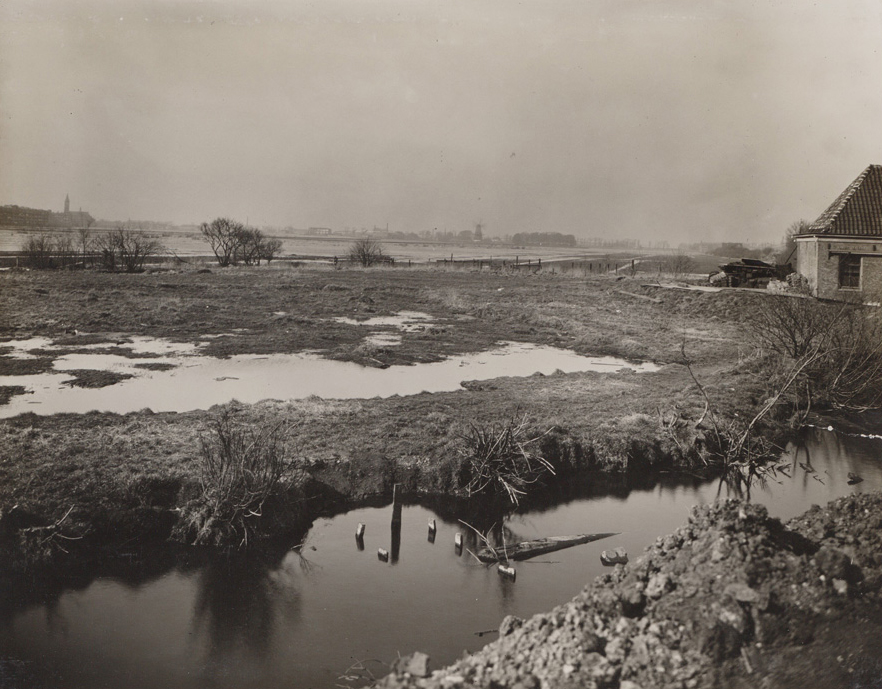
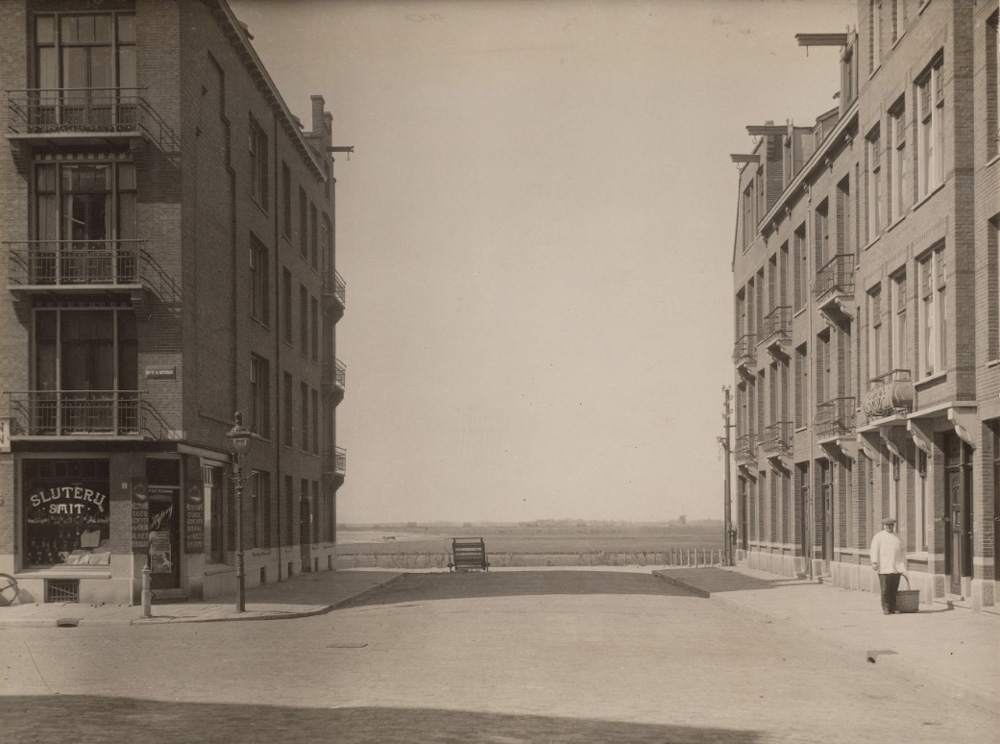
To the west of Amsterdam, the city stopped abruptly at the corner of Witte de Withstraat/ Jan Evertsenstraat.
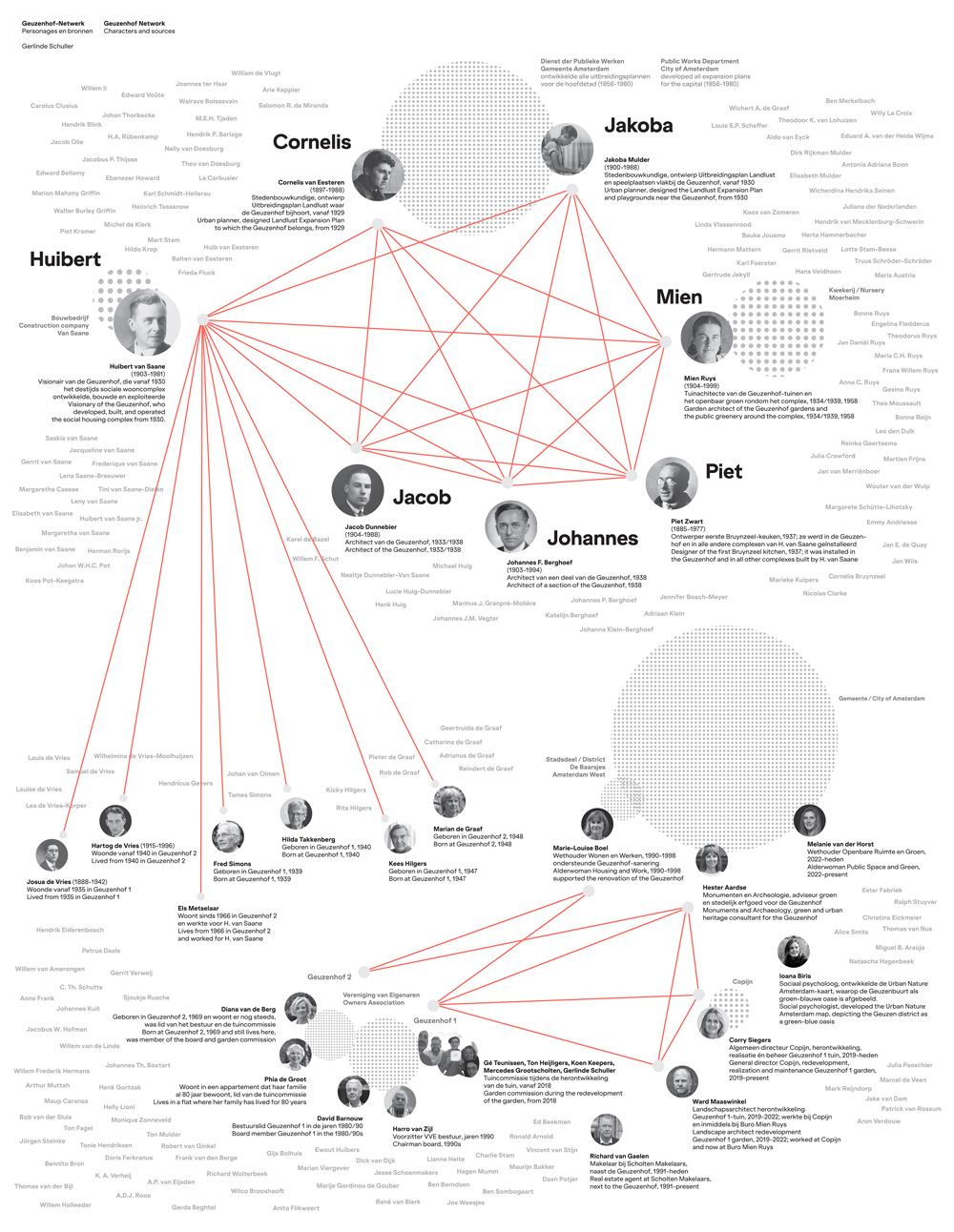
Geuzenhof is an interdisciplinary, collaborative long-term effort of professionals and residents, 1931-present
My project also examines how the social green heritage of Geuzenhof is being made future-proof. It discusses issues related to the future approach to social green concerns, citizen participation, climate-appropriate urban planning, and the legal rights of nature.
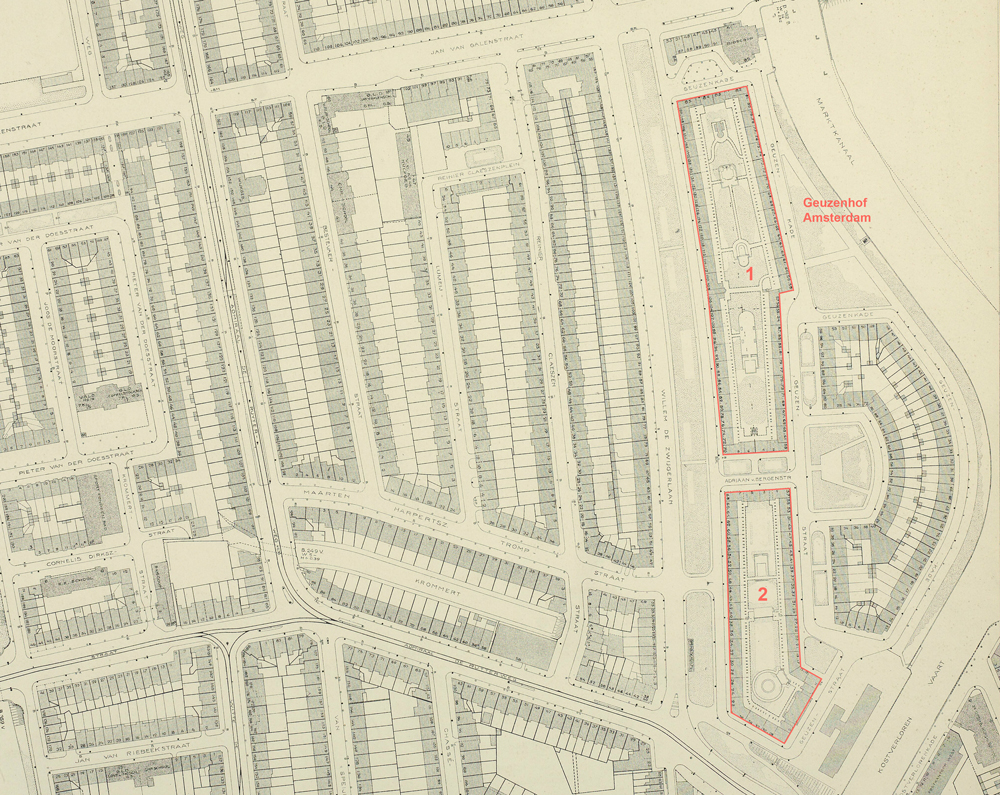
The map shows the entire complex in 1941.
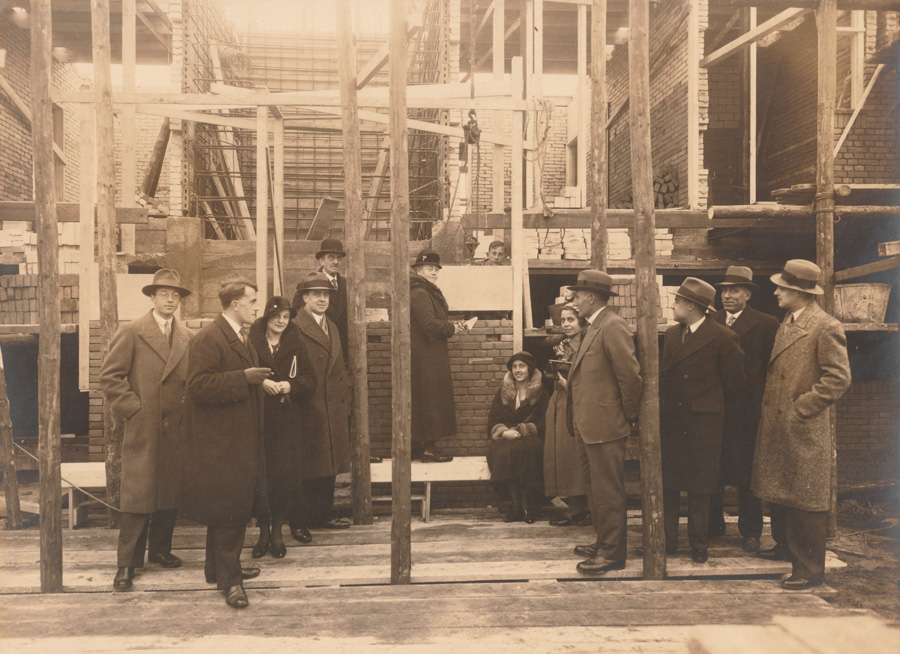

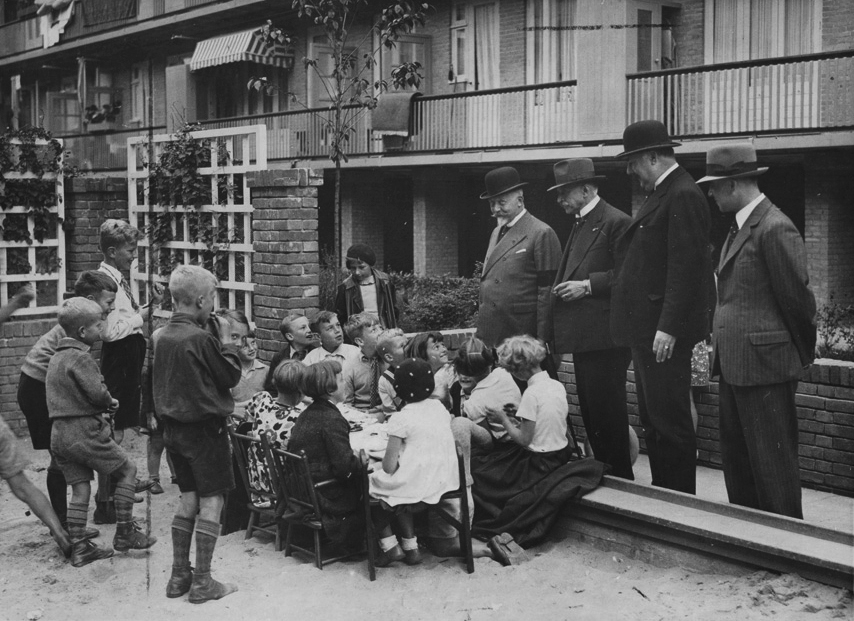

The ‘unfinished’ Geuzenhof complex is visible in the background, 1938.
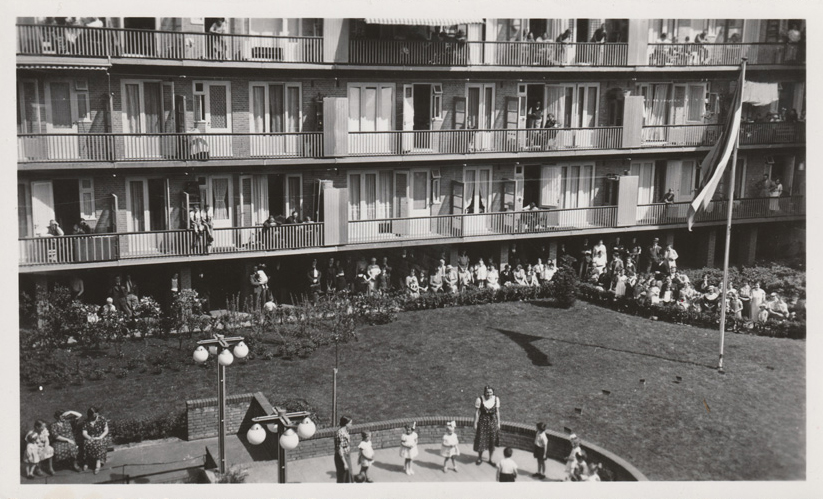
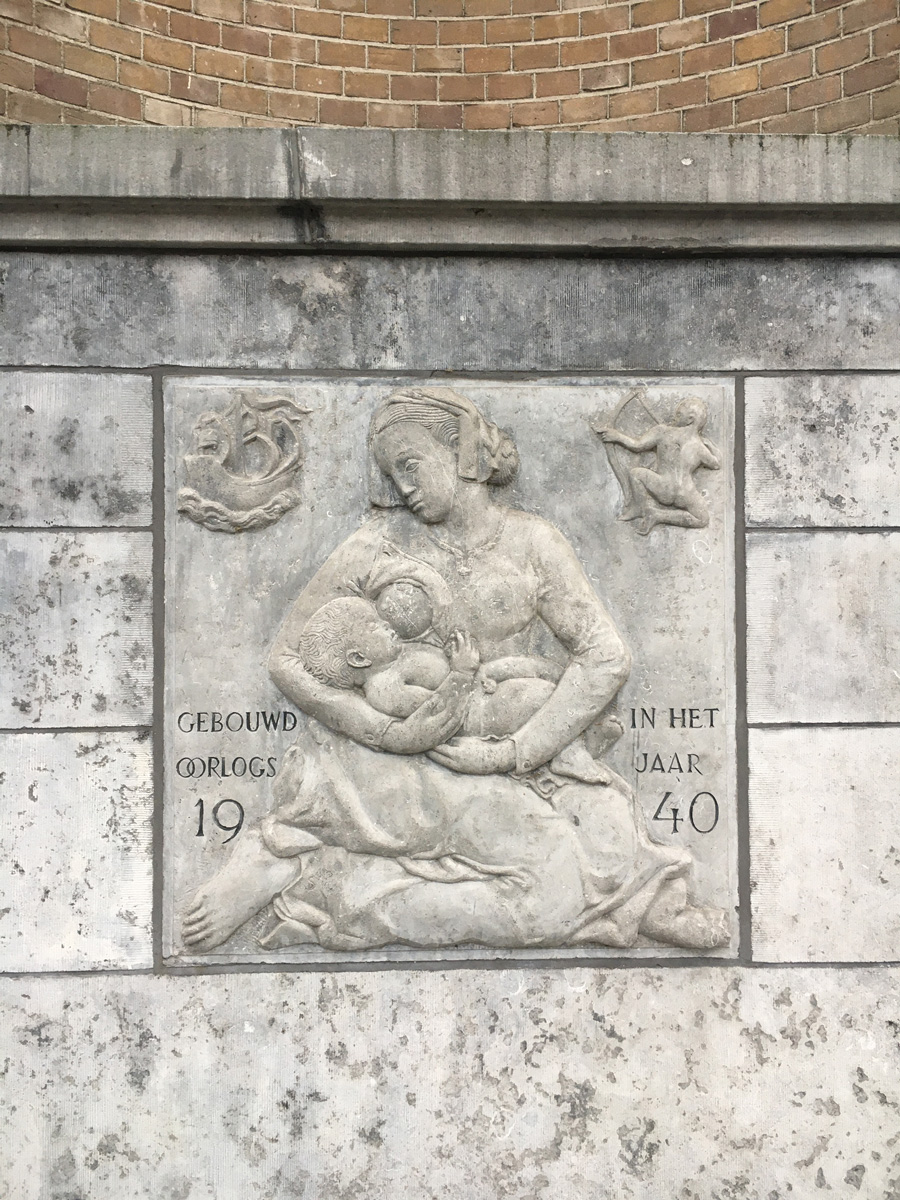
of a breastfeeding mother and the inscription ‘Built in the war year 1940’.

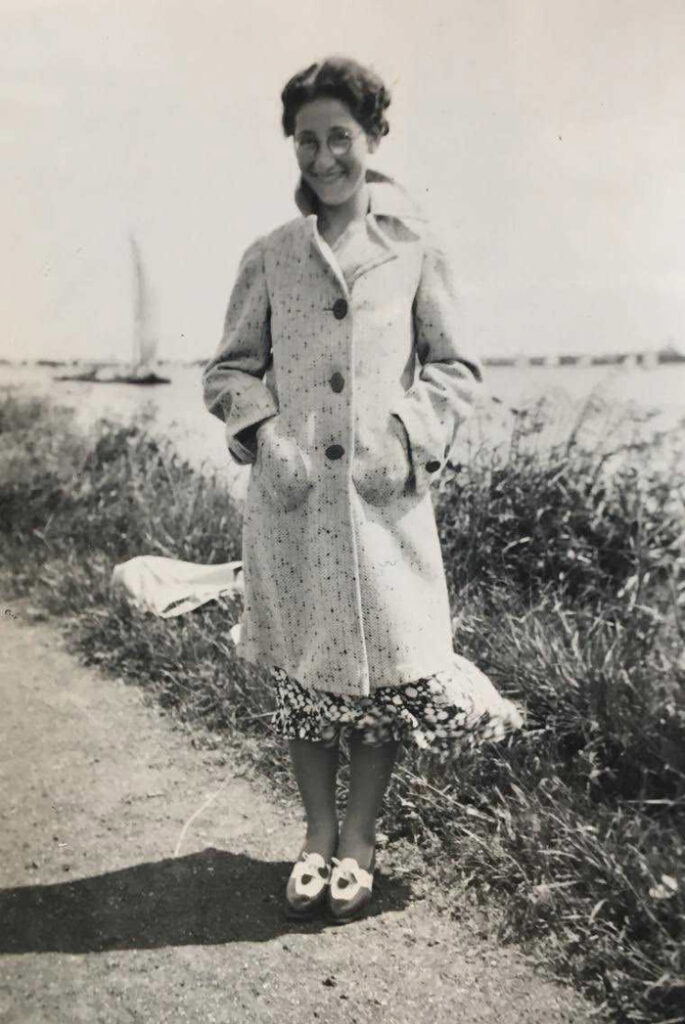
Among them were Lea, Josua and their daughter Louise de Vries. They are pictured here during an excursion, presumably in 1942, the year they were murdered in the Auschwitz concentration camp.
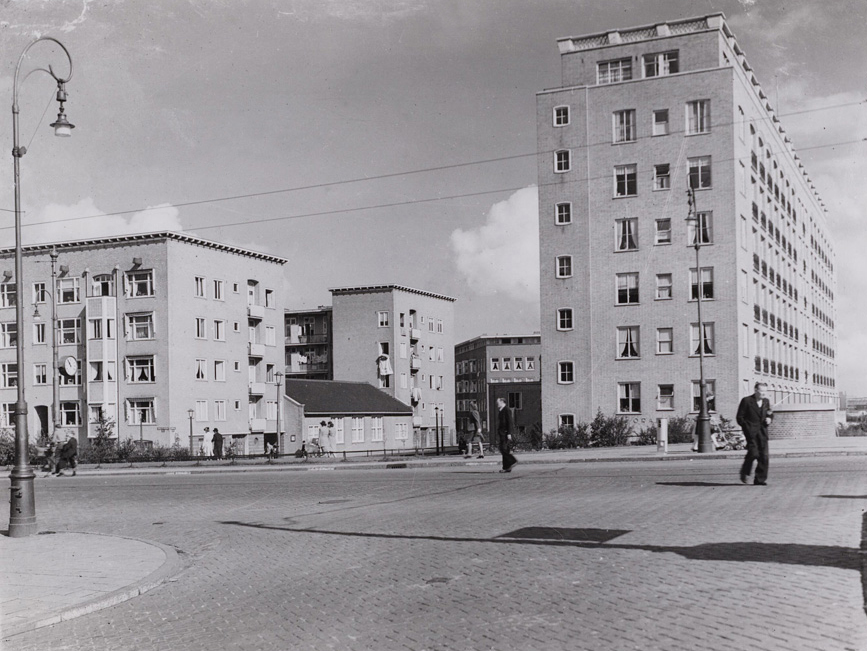
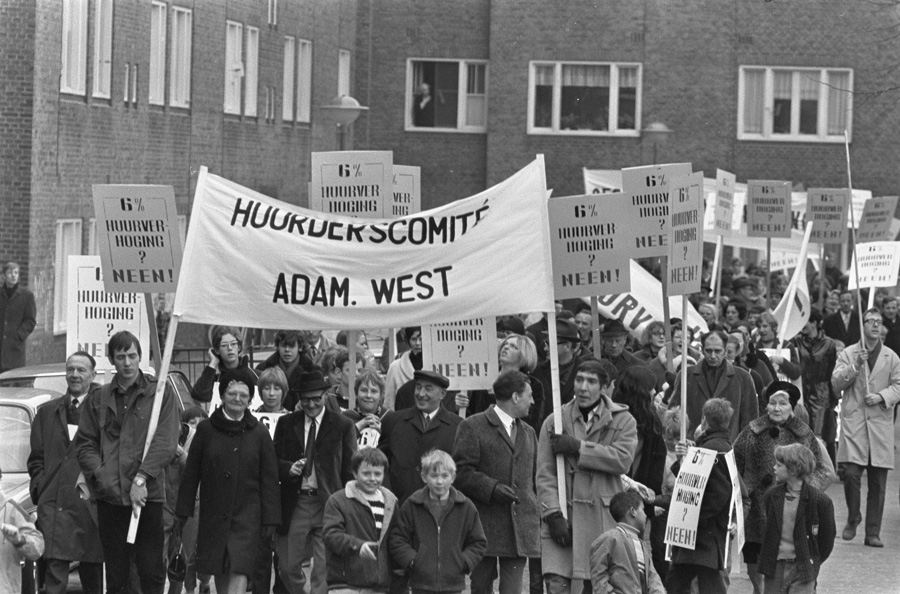
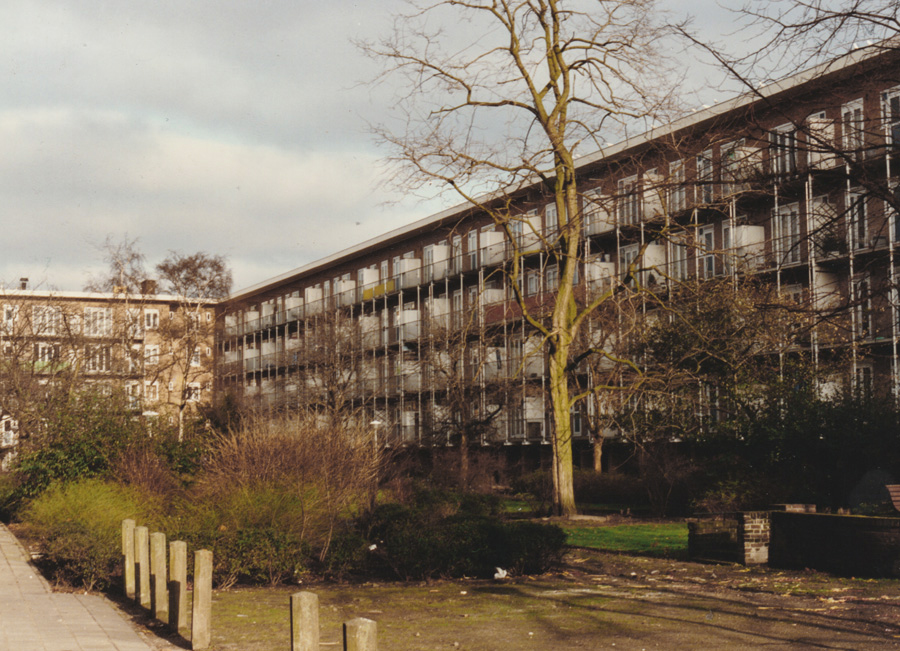
In 1992 the whole complex was finally renovated.
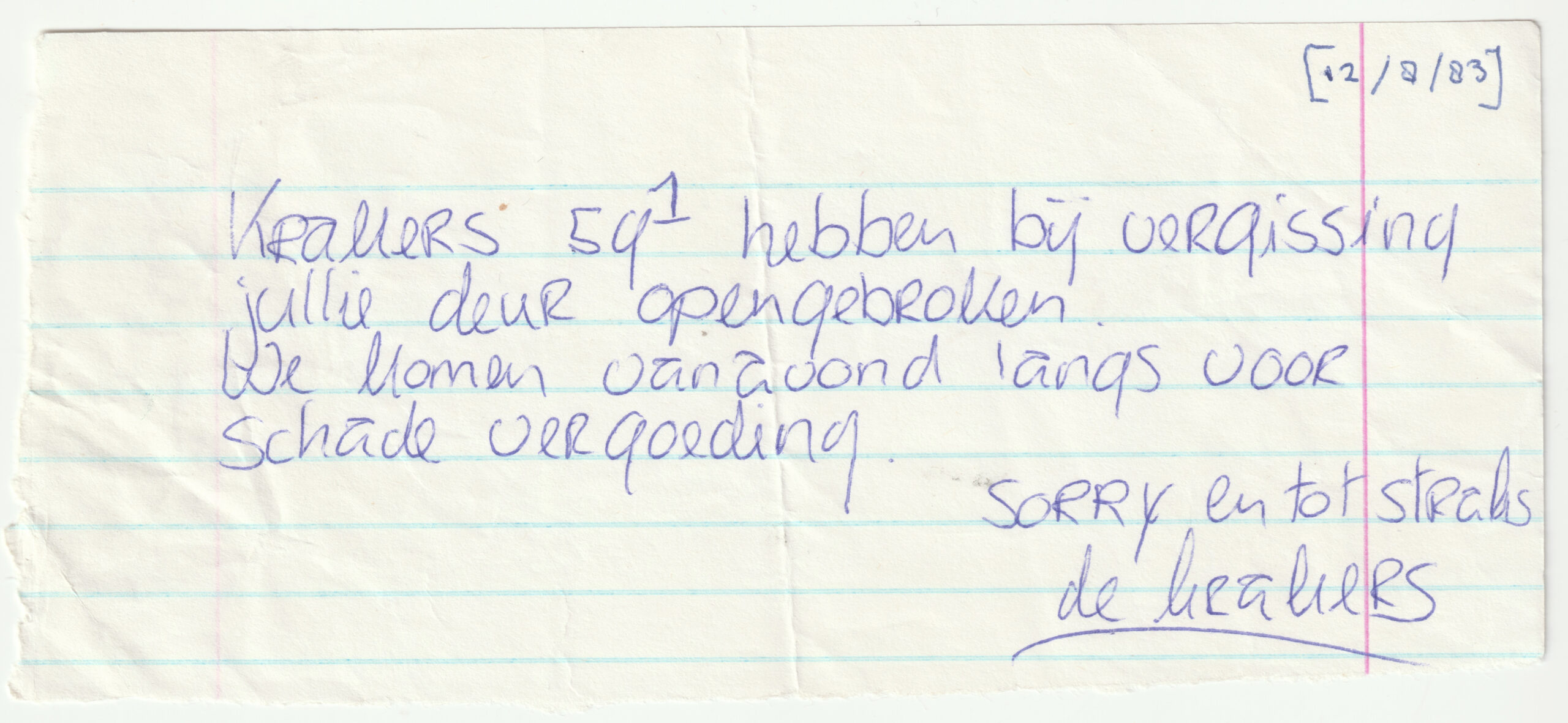
Note on the door of a Geuzenhof flat after squatters broke into the wrong apartment, 12.8.1983.
‘Squatters from 59-1 have accidentally broken open your door. We are coming by tonight to compensate for the damage. Sorry and see you later, the squatters.‘
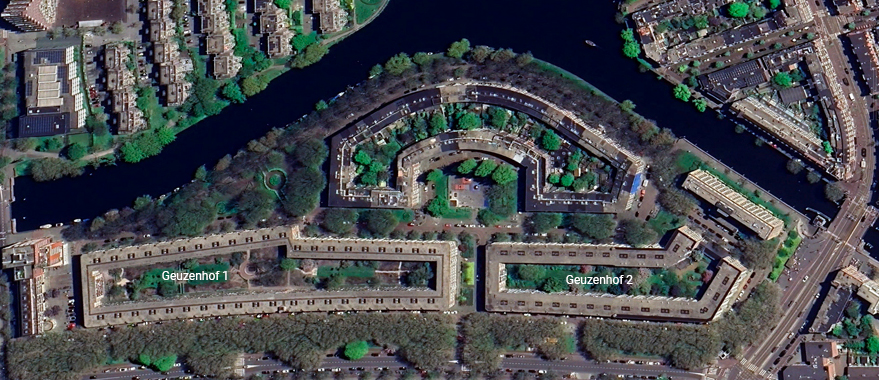
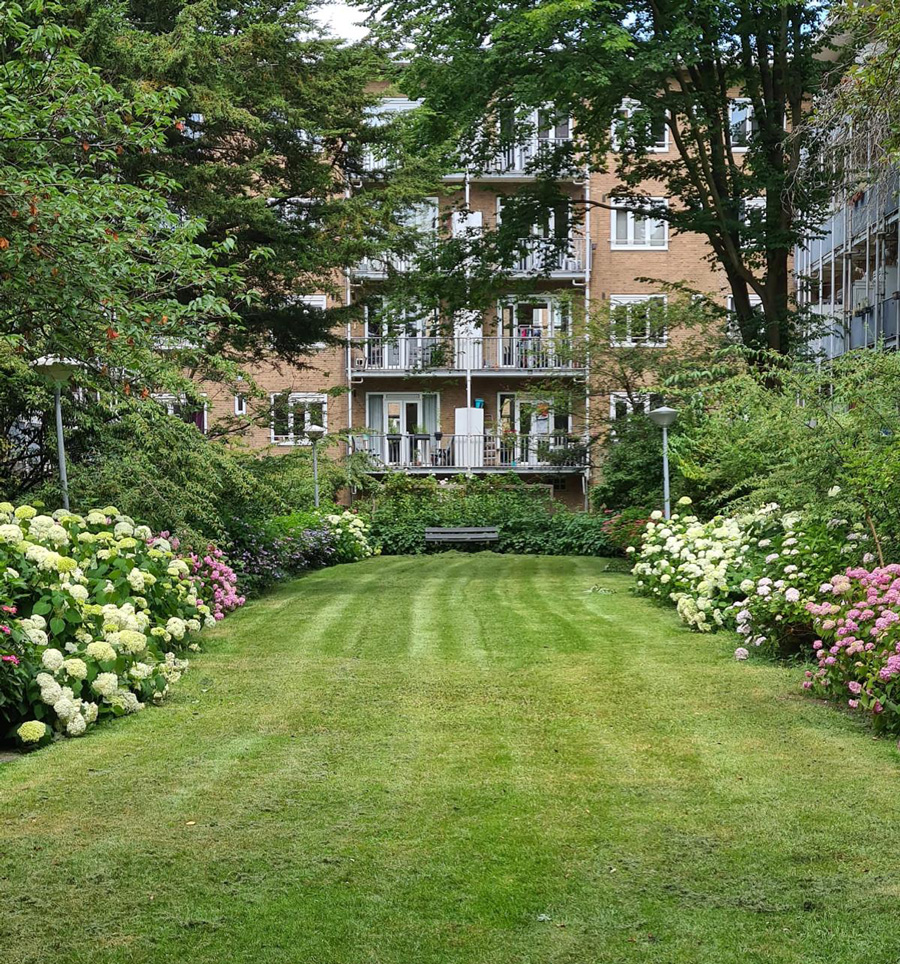
The garden was redeveloped around 2000.
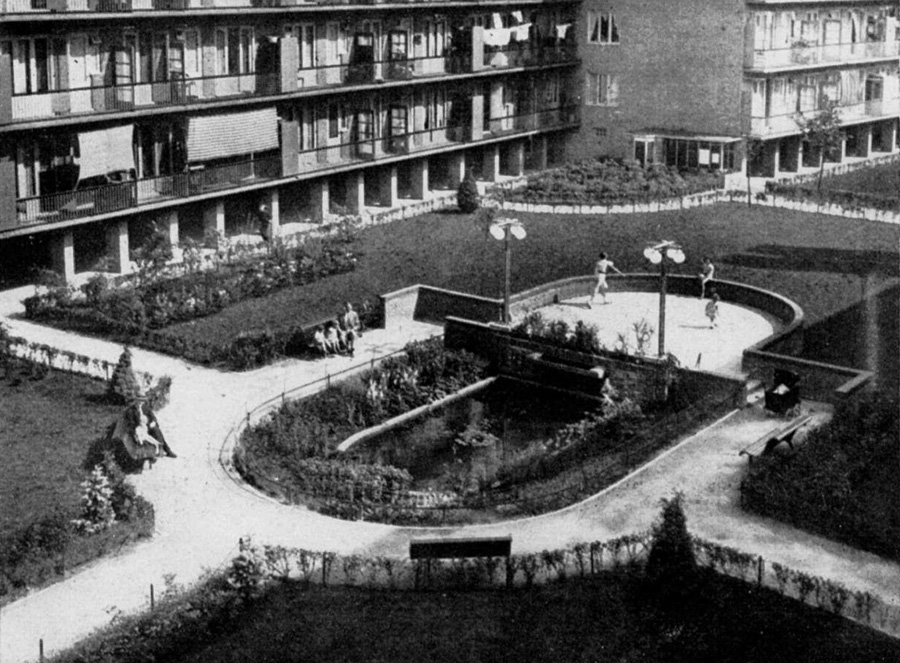
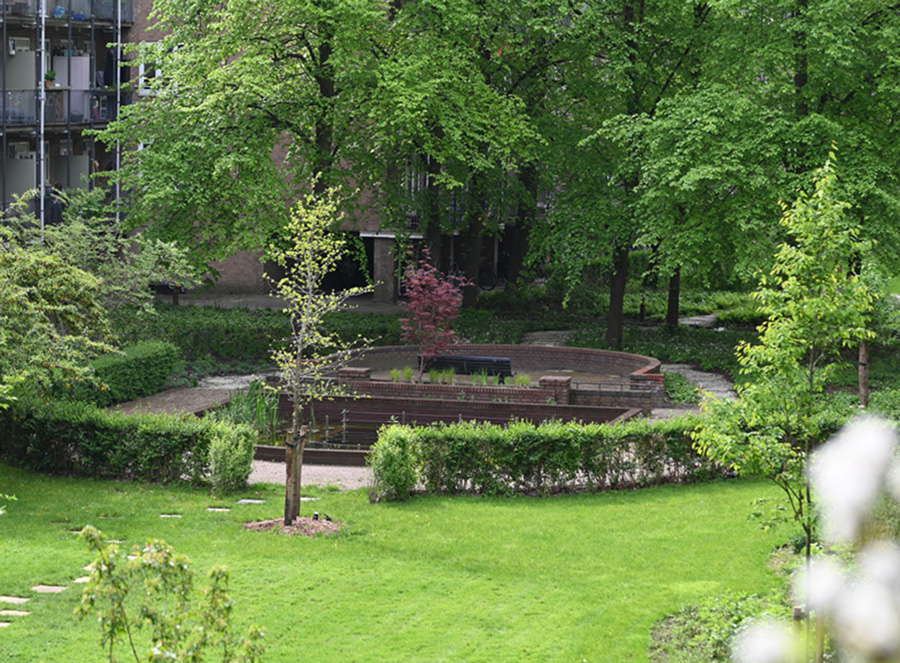
The pond by Mien Ruys (left, 1935), that had been drained for decades, was replaced by a new pond designed by Copijn Landscape Architects (right, 2024).
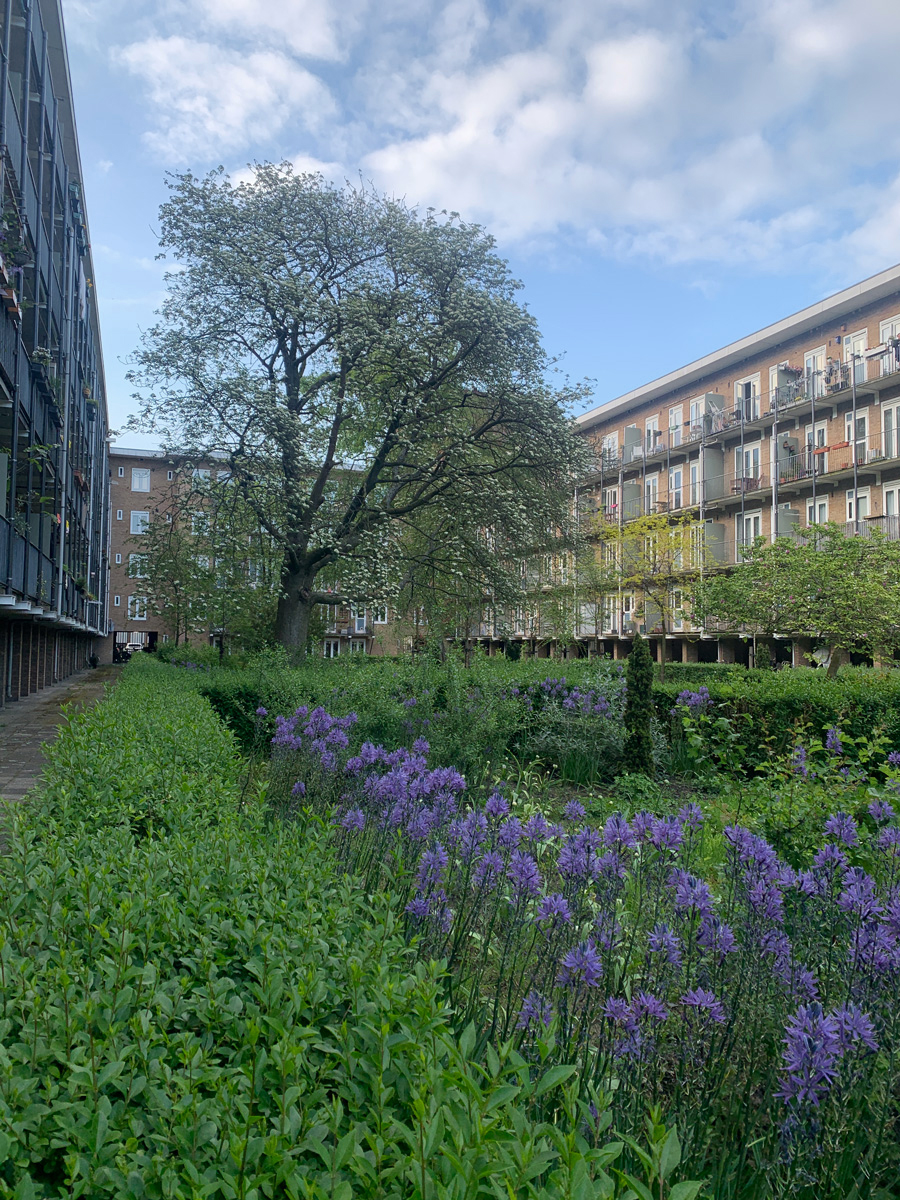
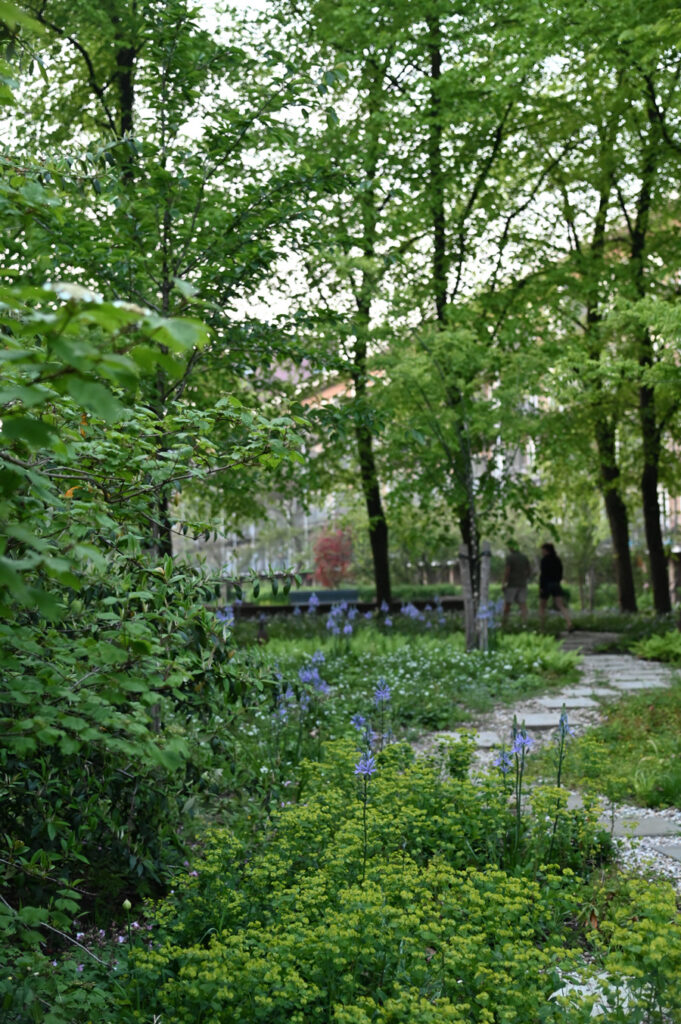
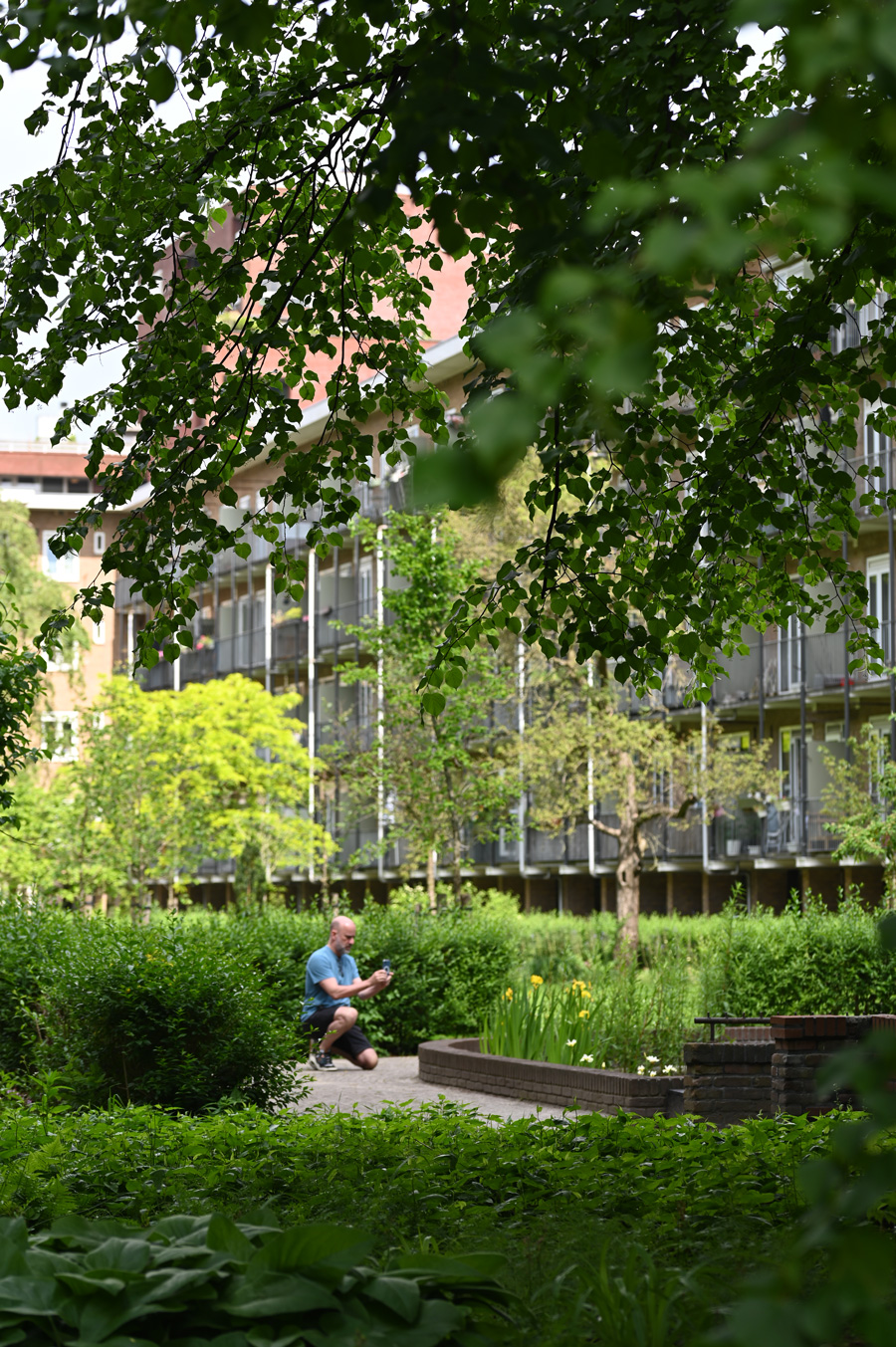
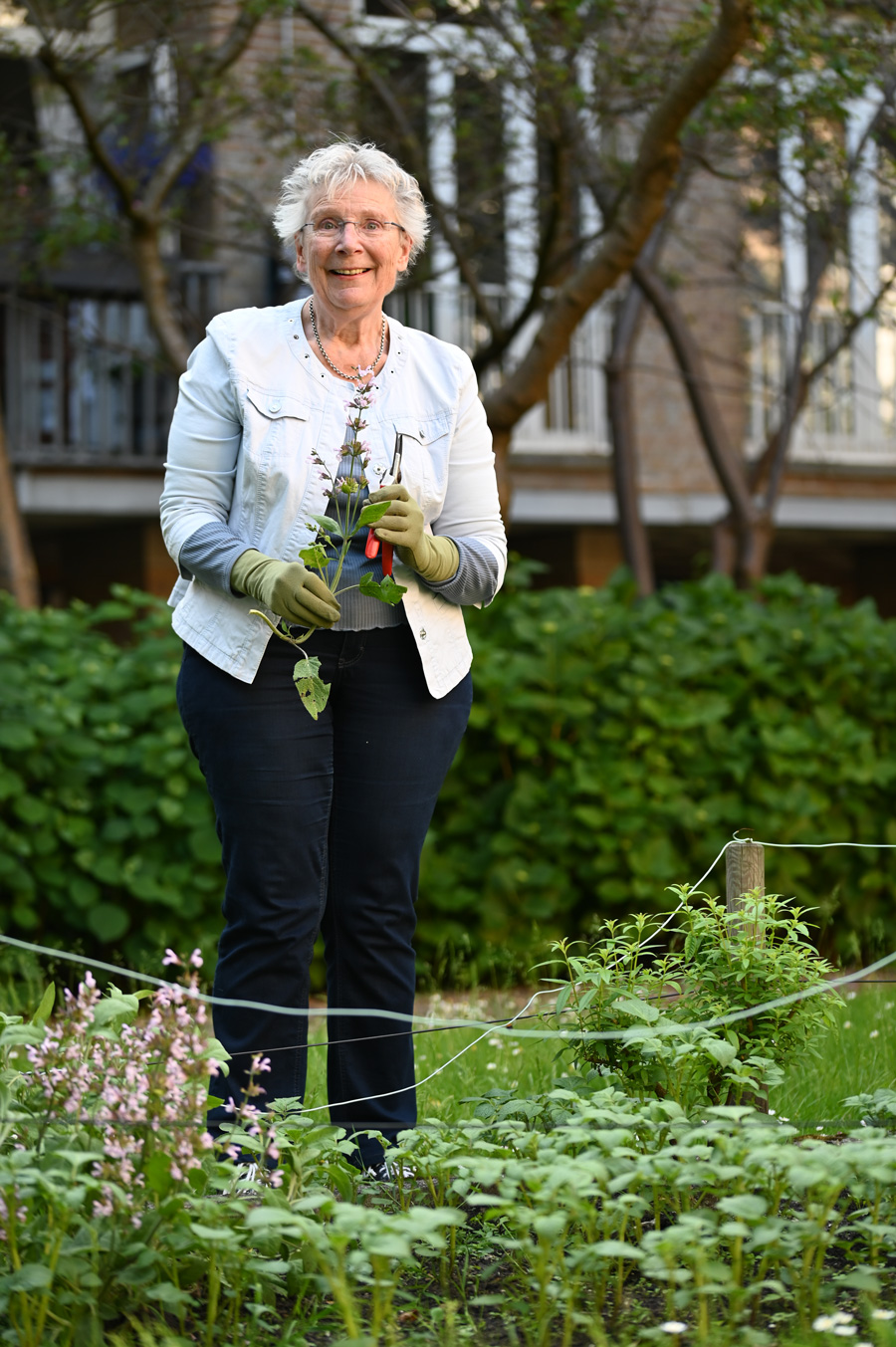
Members of the garden commission of Geuzenhof 1 and 2 – Gé Teunissen and Phia de Groot – in the Geuzenhof gardens. The commissions initiated the redevelopment of their monumental gardens and also supervise the maintenance.
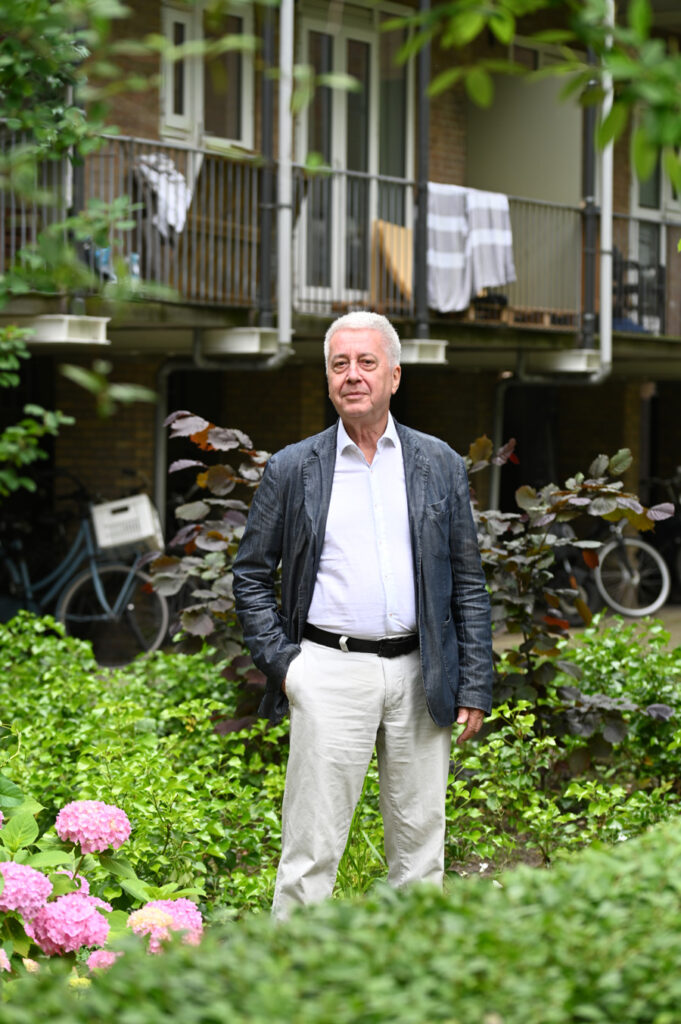
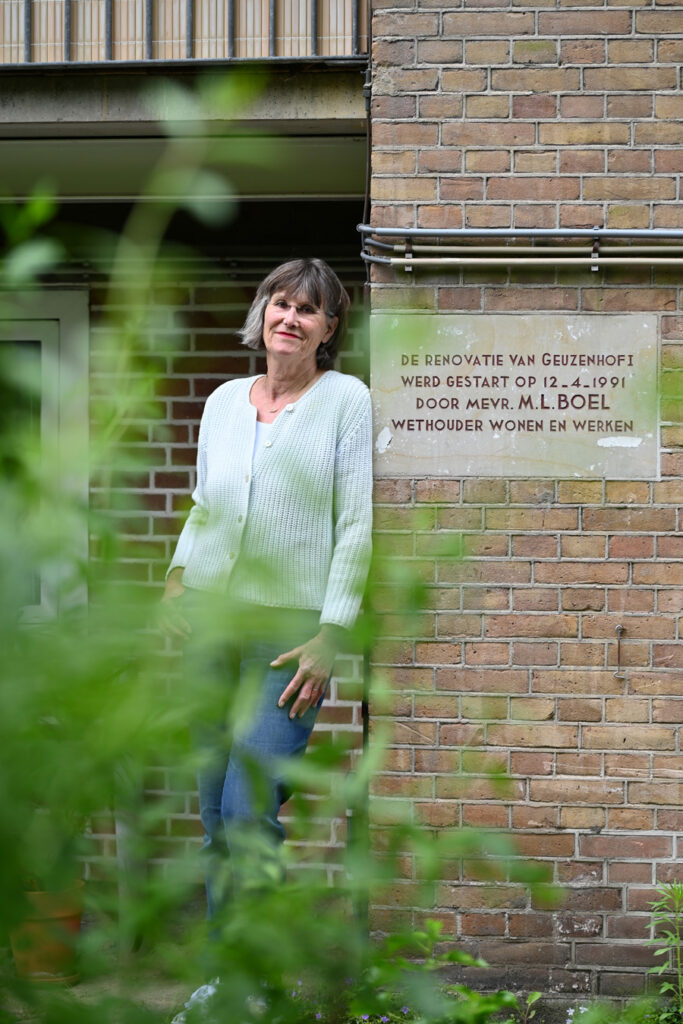
Marie-Louise Boel co-financed the complete renovation of Geuzenhof, as the city councillor for housing in the De Baarsjes district in 1991/1992. She stands next to the memorial plaque in Geuzenhof 1 that commemorates this milestone.
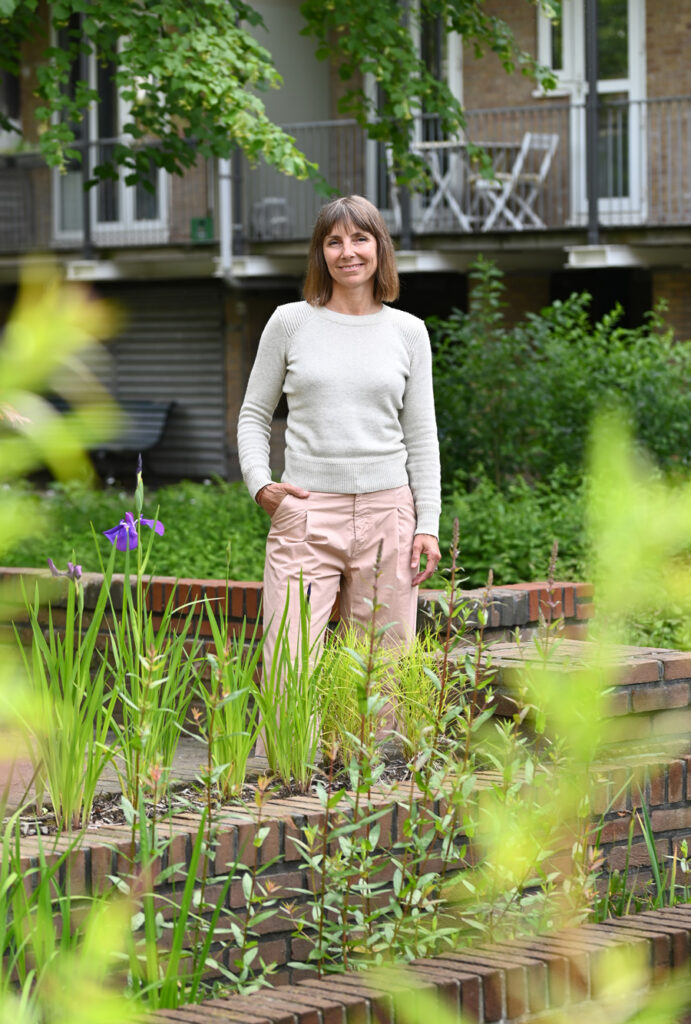
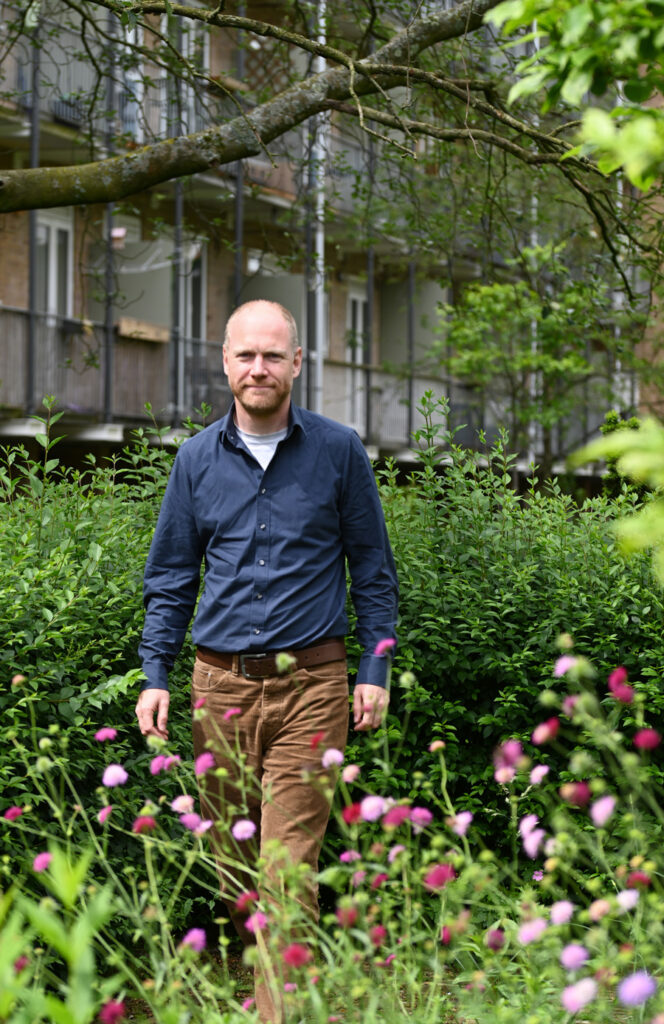
Landscape architect Ward Maaswinkel, who designed the redevelopment plan for the Geuzenhof 1 garden, inspects the blooming Mien Ruys-flowerbed, which he created in honour of the original garden architect.
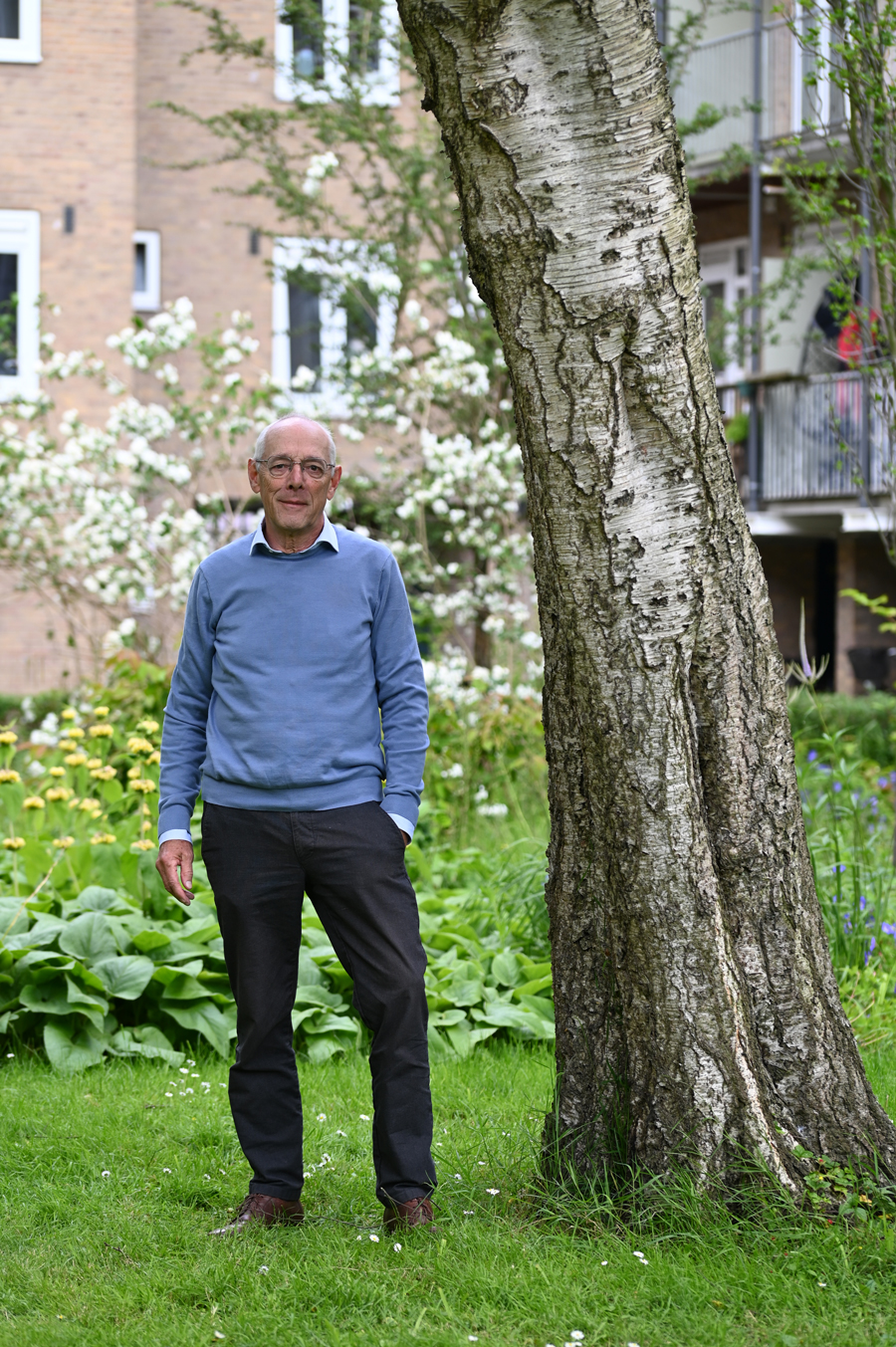
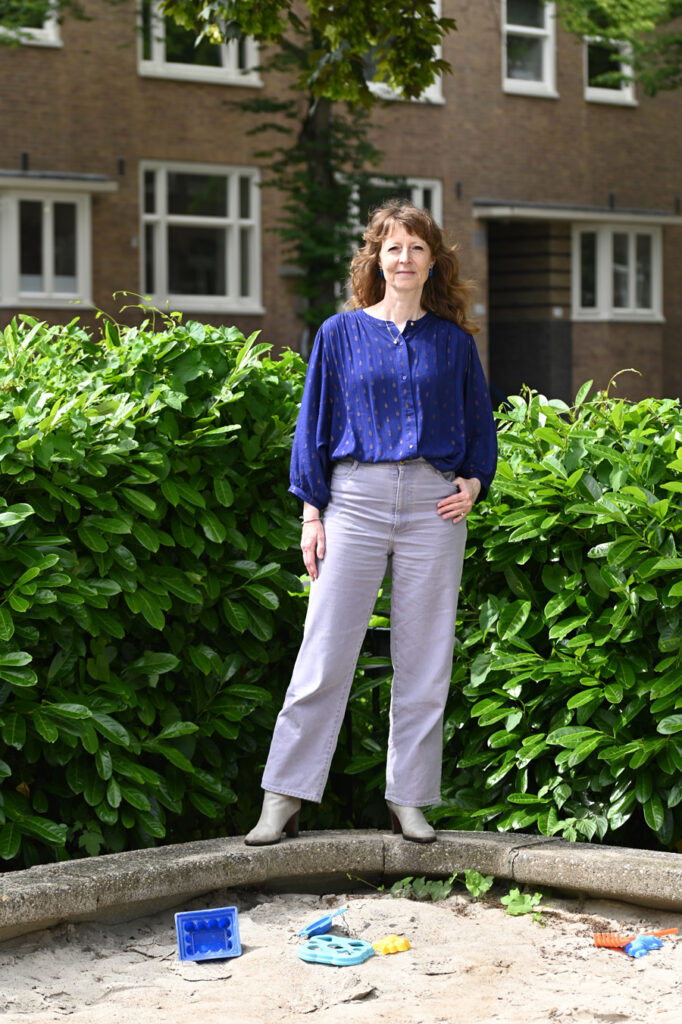
Architectural historian Linda Vlassenrood, who writes a dissertation on urban planner Jakoba Mulder poses in front of the Geuzenhof on the playground that Mulder laid out at the end of the 1940s.
